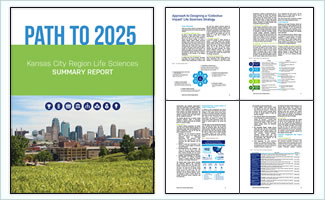
In partnership with Deloitte, the Kansas City Area Life Sciences Institute (KCALSI) conducted a strategic assessment of the regional life sciences to identify a shared vision for enhancing the life sciences over the next decade.
The first phase of the strategic assessment, which was announced at the KCALSI Annual Dinner in September 2015, included over 150 interviews and a survey sent to over 1200 people in the region. To avoid an insular view, the Kansas City region was benchmarked against 15 life science clusters around the globe in addition to analyzing both drivers of cluster enhancement and regional scientific strengths. The process utilized the “Collective Impact” model from Stanford and was led by an experienced steering committee comprised of life sciences and community leaders. Recognizing and respecting the tremendous accomplishments of the institutions in our region, the steering committee sought to find a common vision that would be supported by all.
The new collective vision for the region which resulted from the assessment states, “The Kansas City region is a global leader at the nexus of human and animal health benefiting all our citizens and the economy.” The vision is aspirational yet achievable, as the region leverages opportunities at the nexus of human and animal health and reduces healthcare disparities. These nexus opportunities will be different for everyone and will likely range from using naturally occurring cancer in dogs for accelerating human discoveries to developing health IT and bioinformatics approaches for animal health.
Four areas of scientific strength were identified in the “Path to 2025” report, including animal health, cancer research and care, neuroscience, and outcomes research and health IT. Additionally, the report identified four drivers of cluster enhancement. These drivers include collaboration, workforce development, capital formation, and messaging and marketing. KCALSI believes these cluster drivers will be critical for the success of our entire ecosystem and enable us to be more globally competitive.
The second phase of the strategic assessment engages members of the life sciences community to begin assessing and developing initiatives for the areas of focus identified in the assessment. For each of the four areas of scientific strength identified in the report, a working group has been formed and is meeting to discuss objectives, implementation plans, and time-driven metrics for success. Similarly, for each of the four drivers of cluster enhancement identified, a task force was formed and will also develop goals and plans.

Areas of Scientific Strength
The strategy utilized predominantly interviews, baseline research, and workshop inputs, to identify these areas for focused development and investment. These areas provide the region with opportunities to distinguish itself in an increasingly competitive life sciences landscape.
- Animal Health—Regional industry, academic, and government assets represent a concentration of unique animal health strengths, making the sector a true regional differentiator.
- Outcomes Research and Health IT—This focus area highlights a balance between current realities and aspirational achievement. Potential for growth lies in the ability to align regional informatics assets with the industry’s trends toward value based care.
- Cancer Research and Care—This area acknowledged significant community support for the region’s cancer capabilities in addition to the potential for increased regional competitiveness via collaboration and outreach.
- Neuroscience—A focus on neuroscience supports evolving hospital programs and builds upon the momentum of recent research opportunities to pursue the region’s potential to become a strong player in this area.
Drivers of Cluster Enhancement
Using information gathered primarily from interviews, surveys, and workshop inputs, the strategy identified these four cross-cutting areas that need to be bolstered in order for the region to truly compete with top tier life sciences clusters.
- Collaboration—Five types of collaboration needs: Executive to Executive, Researcher to Researcher, Researcher to Industry, Industry to Higher Education and Entrepreneurs to Researchers.
- Workforce Development—Target group: Full spectrum of education, P-20.
- Capital Formation—Primary regional life sciences investment needs: Seed capital (including venture capital), Angel investment, and Federal grants.
- Marketing and Messaging—Broad target audiences include: the local life sciences community, the regional community at large, and the national and global communities.
The full report is available online at www.kclifesciences.org/reports/path-to-2025.